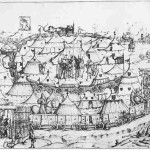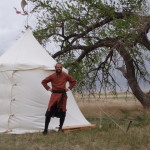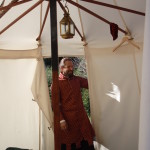The Round Pavilion, What held them up?
A survey of period art will show a great number of round pavilions. While it is uncertain exactly what held them up, it is certain that they used a center pole, as this can be seen in many paintings and engravings. It is clear that some of these tents were held up with just the center-pole and a forest of guy lines running far out from the eaves.
However, it also seems clear that not all round pavilions were set up this way.There is some evidence that the hub & spoke method was used. Further evidence can be assumed from the fact that, not only was all the technology to do it available, it also works extremely well. A competing theory holds that a springy wooden hoop was attached into the eaves of the roof and that this is what held the roof out.
Personally, I think it likely that the first two methods were used at times depending on local preference. So far, I’ve found the evidence for the hoop method unconvincing, but I’m always looking for more information.
Packing
Because a circle has the most area for its perimeter of any shape, a round pavilion gives the most possible floor space for the amount of canvas. This means that you have less bulk and weight to carry.
Also, because I make separate roof and walls, you end up with three pieces that fold flat and are easy to carry. Because the spokes are smaller than side poles, the amount of wood you must carry is also much less than with most other styles of tent. Note: It is definitely period practice to do this either way, both toggled wall attachments and sewn in walls can be found on extant tents and in period art.
Set-up
I will include complete set-up instructions elsewhere, but suffice it to say that a round pavilion sufficient to hold a queen sized bed can be set up by a single person, completely unaided, in about thirty minutes. (I’ve personally done it in 29 minutes, in the dark, starting with the poles still tied to the roof rack.) A large round pavilion, big enough for kitchen for a household of 30 or so, or to house a whole family, with a king sized bed for mother and father and separate spaces for kitchen and children, can still be set up single handed, though it will take a bit longer.
Living in It
Aside from the beauty of the structure, which is considerable, the spokes are very useful for storage. All sorts of lightweight items can be put “in the attic”. A clothes rack becomes unnecessary, just bring hangers and hang clothes from the spokes around the perimeter. Also not to be underestimated is the ability to lay out wet clothes to dry. There’s plenty of room overhead. In hot weather, the high peak allows the hot air to rise above your head where you don’t feel it. Two doors allow catching a cross breeze when necessary.
Weather
The round shape, combined with sloped walls, makes for a tent that sheds wind readily. The picture at left was taken at an event called Crossroads, but that shall hereafter be known as “CrossWinds”. The picture was taken with winds at 45 mph and gusting to 60+. Normally, after set-up, I’d take the guy lines down so people don’t trip over them. This time I chickened out and left them up. As an aside, it did take two of us to set up in this weather.
Thankfully, the storm only sideswiped us. About fifty miles north an F3-F4 tornado touched down and destroyed most of a small town.
Versatility
With removable walls, the doors can be opened up to virtually whatever size is desired. This works great by the list field where you can set up as a sunshade with integral windbreak.


